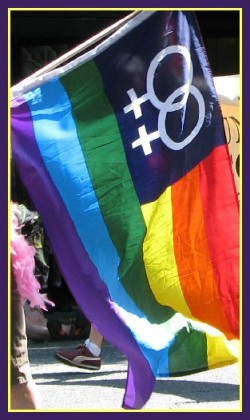Ed Note: This post was originally published on Huffington Post and is reprinted with permission from the author, Rabbi Andrea Myers. If you like this post, please check out her book, The Choosing: A Rabbi’s Journey from Silent Nights to High Holy Days’ (Rutgers University Press, April 2011).
Living on Long Island as a sheltered teenager in the ’80s, the term “lesbian” might as well have been a country in the Middle East, somewhere in the Interzone between Mesopotamia and Bilitis, due south of the Well of Loneliness.
That was a long time ago. I came out in college, and am now married to my partner of 13 years. All told, we are officially married in Canada, officially domesticated in New York City and religiously married by a rabbi with a proud history of civil disobedience — and we have the requisite assortment of children and cats. While some might stereotype my life as being heteronormative, I am an unapologetic queer, who has never been either heterosexual or normative.
I am also a rabbi. I grew up as a Lutheran, went to Brandeis (not knowing it was Jewish), discovered Judaism there, studied and converted in Israel and was ordained by the Academy for Jewish Religion in New York City. By some accounts, the different aspects of my identity should be in tension with each other: a rabbi with non-Jewish parents, someone who is both religious and gay. In reality, though, all these elements are integrated and related. An essential part of my theology is that God wants us to live fulfilling, joyous lives. “Choose life,” we are told in the Torah, “so that you and your descendants may live” (Deut. 30:19).
For too long, discussions of Judaism and LGBTQ life have focused on what is permitted and not permitted, and on how to make room for oneself within the limits of the tradition. Specifically, the prohibition in Leviticus (Lev. 18:22 and 20:13) is cited again and again, as the starting point for any conversation about Judaism and sexual identity.
But I am a liberal rabbi, and I believe strongly that traditions can and must change. I want to share a different way to think about what it means to be a LGBTQ Jew, based on the premise that God made us who we are. There is a concept in Judaism known as hiddur mitzvah, which means taking something that is commanded and making it beautiful. The idea is based on a biblical verse, Exodus 15:2: “This is my God who I will glorify.” Rabbi Ishmael asks: “Is it possible for a human being to add glory to his Creator? What this really means is: I shall glorify God in the way I perform mitzvot [commandments]” (Mekhilta Shirata 3).
So when I think about being both gay and Jewish, the question I ask is not, “Is my life and are my actions prohibited by the biblical text and rabbinic tradition?” The questions I ask instead are these: How can I live my life in a way that is beautiful? How can I actively choose the life that is mine to live?
My partner and I got married in October 2001, a month after 9/11. We briefly considered calling the wedding off; it didn’t feel like the right time to celebrate. But then we realized that there is no better way to fight terrorism than a big gay Jewish wedding in New York City. And if we were going to do it, we wanted to do it right. We wanted to make it beautiful. For my side of the family, an open bar was critical. For me and my partner, the focus was on a custom ketubah (Jewish marriage contract) with language and artwork that reflected our theology and hopes — and our shared fascination with the art of medieval Jewish illumination. The point of all of it was hiddur mitzvah.
Ultimately, that is what I want to convey to anyone trying to figure out the synergy of their Jewish and LGBTQ identities: how to live with dignity and humor, beauty and joy, as you take your place in a Jewish tradition that is thousands of years old. It is easy to feel scared and marginalized as a queer person in a straight world, and especially one that uses the language of religion to exclude. Within the LGBTQ community, it is easy to feel lost in the ever-shifting alphabet soup of sexual and gender identifying labels. The Torah tells us that all of us were made in God’s image (Gen. 1:27), so wherever you are on this particular rainbow, there is something in you that is divine. If it’s good enough for God, it should be good enough for your fellow human beings, kal v’chomer, all the more so, for your fellow Jews. Your life shouldn’t look like mine or your parents’ or your neighbor’s; it should look like your own, and whatever you dream it to be. As Herzl said, Im tirzu, ein zo aggadah, “If you really want it, it is no dream.”
Moved to action by a series of tragic suicides of gay youth and the epidemic of bullying in our nation’s schools, Dan Savage and Terry Miller started the important “It Gets Better” campaign. The idea was to encourage LGBTQ people and allies to share stories about how life got better for them. I am blessed and lucky that it got better for me too. But the phrase “It Gets Better,” essential as it is, leaves me wanting more. It shouldn’t just get better. Colds get better. Life should get beautiful — and I hope, sometimes, hilarious.
